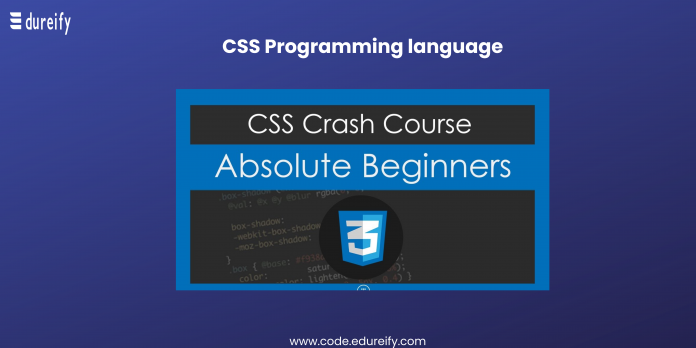CSS (Cascading Style Sheets) is used to style and layout web pages — for example, to alter the font, color, size, and spacing of your content, split it into multiple columns, or add animations and other decorative features. This module provides a gentle beginning to your path towards CSS mastery with the basics of how it works, what the syntax looks like, and how you can start using it to add styling to HTML.
Also, read about the Web Development course which will help learn CSS too.
Main Components of CSS
In the Above Section, we have studied Introduction to CSS, So now we are going ahead with the main components of CSS are as below:
- Easily maintainable: If you are intended to make any global change, simply change the styling, and you can see all other elements in all other web pages getting automatically updated.
- CSS is time-saving: You can just write the script once and reuse the same sheet as much time as you want.
- Superior styles to the native front end: CSS has comparatively a much wider array of attributes and lists if compared to HTML. Therefore the HTML page can have a brighter look and feel if compared to the normal HTML attributes.
- Ease with Search Engines: CSS is considered a very convenient and easy-to-read styling sheet. This means that the search engines don’t have to put in a lot of effort in trying to read the text.
- Efficient cache storing: CSS can be used to store the web applications locally with the help of an offline cache mechanism that can be used to view offline websites. Download the Eduriefy app now to know in-depth about the CSS course.
Characteristics of CSS
As we discussed the introduction to CSS and Its components. Now we are going to learn about the characteristics of CSS. The major characteristics of CSS include styling rules which are interpreted by the client browser and applied to various elements in your document. Major characteristics include:
- A style rule consists of a selector component and a declaration block component.
- The selector is used to point to the HTML component which you want to get styled.
- Inside the declaration block, one or more declarations are contained along with semicolons.
- Every declaration which is put has a CSS property name, a semicolon, and a value. For example, the color is the property, and the value is read. Font size is the property, and the 15px is the value.
- CSS declaration ends with a semicolon, and these blocks are surrounded by curly braces.
- CSS selectors are the ones that are used to find HTML elements that are based on the element name, id, attribute, class, and more.
- One unique element will be selected by the ID of an element.
- If you wish to select a particular element with a specific id, the # function along with the id attribute should be used.
- If you wish to select the elements with a specific class, the period character along with the name class should be written.
- Universal selector: If you are not interested in choosing the elements of a certain type, the universal selector simply matches the element name.
- Element selector: These selectors choose the element based on the element name.
- Descendant selector: When a particular element lies inside another element, then it is called the descendent selector.
- ID selector: This selector uses the id of the HTML element so that a specific element could be selected.
- Class selectors: It selects the element with a specific class attribute.
- Grouping selectors: It will be a good option to group the selectors to minimize the code. Each selector, along with a comma, should be used to group the selectors.
Also, read about the SQL course and a brief about the same.
Applications of CSS
After learning the Introduction to CSS and the characteristics of CSS, we are going to learn the application of CSS. There are three ways of HTML accessing CSS:
- Inline
An inline style sheet is only used to affect the tag it is in. This essentially means that the small details on the page can be changed without changing the overall layout of the page.
- Internal
The internal would only be used when you wanted to add a small change in a single tag. This is because inline only affects the one tag that is contained within it, whereas the internal styling is put on the head of the HTML document.
- External
External stylesheets are used to allow people to format and recreate their web pages on an entirely different document. This effectively means that you can have two or more workplaces.
CSS gives the power to the web designer so that extensive changes could be given to the web layout of all pages in a single website by making use of just a single file. It helps in designing light and creative websites with high responsiveness which impresses the audience when displayed. Therefore, it is an integral part of the websites today which should not be overlooked. Visit our official website to know about the course and proceed further.
Interview Questions
Question: What is CSS?
Answer: CSS or Cascading Style Sheets is a styling language that is simple enough for HTML elements that find usage in web designing. Besides, the application of CSS is also found in XHTML.
Question: What are the different variations of CSS?
Answer: The different variations of CSS include:
- CSS 4
- CSS 3
- CSS 2.1
- CSS 2
- CSS 1
Question: What are the benefits of using CSS?
Answer: There are multiple benefits of using CSS, such as:
Accessibility
Page reformatting
Site-wide consistency
Bandwidth
Separation of the bandwidth of presentation
Question: What are the disadvantages of CSS?
Answer: The disadvantages of using CSS are:
- Target-specific texts, styling, and rules are not allowed.
- There are no expressions.
- There is no dynamic behavior to control pseudo-class.
- It is not possible to ascend by selectors.
Question: What is meant by CSS frameworks?
Answer: CSS frameworks are pre-planned libraries, allowing a more convenient web page styling that is also compliant with standards.
Question: Give a few examples of modules found in the present version of CSS.
Answer: Some of the commonly used modules in CSS include:
- Box Model
- Selectors
- Text effects
- Backgrounds and Borders
- Animations
- 2D/3D Transformations
Question: What is the difference between CSS2 and CSS3?
Answer:
In CSS2, everything is present in a single document while CSS3 is categorized into multiple sections called modules.
- Graphics-related features such as Box-shadow or Border-radius, flexbox, etc. can be found which are absent in the use of CSS2.
- Properties such as background-position, background image, and background-repeat styles can help use multiple background images in a single webpage.
Question: What do you understand by CSS opacity?
Answer: The technical definition of opacity is the degree to which light is allowed to pass through an object.
CSS opacity is the property used to describe the transparency of an element. Or, in other words, it explains how clear the image is.
Question: How can image repetition of the backup be controlled?
Answer: Background-repetition property controls the repetition of images in the background. Use no-repeat if the image is to be displayed once in the background.
Question: What is the use of the background-position property?
Answer: It can be used to define the initial position of a background image. The default position is the top left of the page. The positions that can be set include top, bottom, left, right, and center.
Question: Which property controls the image scroll in the background?
Answer: Image scroll in the background can be controlled using the background-scroll property.
Question: Why should background and color be used as separate properties?
Answer: This is done with mainly two purposes:
It makes the style sheets more legible. Background property, which is complex in itself, becomes all the more complex with color.
Color is an in-built property while the background is not one. And this can lead to a lot of confusion.
Question: How to center block elements using CSS1?
Answer: To center the block-level elements, we need to set the margin-right and margin-left properties to explicit values.
Question: How to maintain the CSS specifications?
Answer: It is maintained using the World Wide Web Consortium.
Question: What are the ways to integrate CSS as a web page?
There are three methods to integrate CSS in the form of a web page:
- Embedded: There can be a style element inside the head element inside which we can place the code.
- Inline: CSS applied HTML elements can be found using style attributes.
Frequently Asked Questions (FAQs)
Question:- What does CSS mean?
Ans:- Cascading Style Sheets
HTML (the Hypertext Markup Language) and CSS (Cascading Style Sheets) are two of the core technologies for building Web pages. HTML provides the structure of the page, CSS the (visual and aural) layout, for a variety of devices.
Question:- What are the 3 types of CSS?
Answer:- There are three types of CSS which are given below:
- Inline CSS.
- Internal or Embedded CSS.
- External CSS.
Question:- How is CSS different from HTML?
Difference Between HTML and CSS
Answer:- HTML is a markup language used to create static web pages and web applications. CSS is a style sheet language responsible for the presentation of documents written in a markup language.
Question:- Is CSS a framework?
Answer:- A CSS framework is a library allowing for easier, more standards-compliant web design using the Cascading Style Sheets language. Most of these frameworks contain at least a grid.
Master Your Coding Skills with BootSelf AI
If you're looking to enhance your coding abilities and upskill in artificial intelligence, look no further than the BootSelf AI app. This innovative platform provides AI-based coding lessons that are tailored to your individual learning pace.
Available on both iOS and Android, you can download the BootSelf AI app and start mastering coding skills today:






